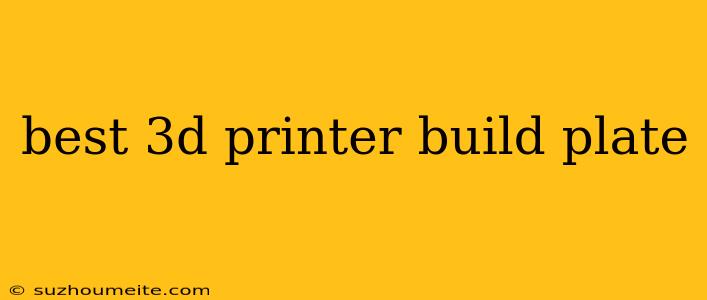Best 3D Printer Build Plates: A Guide to Finding the Perfect Surface
Choosing the right build plate for your 3D printer is essential for achieving successful prints. A good build plate provides a strong, reliable adhesion to your prints while allowing for easy removal once they're done. With so many options available, it can be overwhelming to find the perfect fit.
This guide will break down some of the best 3D printer build plates, covering various types and their pros and cons. By understanding these options, you can choose the ideal build plate that suits your needs and printing preferences.
Types of Build Plates
Here's a breakdown of the most popular build plate types used in 3D printing:
1. Glass Build Plates:
- Pros:
- Excellent Adhesion: Glass provides a smooth, even surface that promotes strong adhesion, especially for materials like PLA and ABS.
- Durable: Glass is a robust material that can withstand high temperatures and repeated use.
- Easy to Clean: Glass surfaces are easy to clean with a gentle cleaning solution.
- Cons:
- Potential for Breakage: While durable, glass is susceptible to breakage if dropped or subjected to sudden temperature changes.
- Heat-Up Time: Glass can take longer to heat up compared to other materials.
- Warpage: Large prints can sometimes warp on glass due to uneven heating.
2. Magnetic Build Plates:
- Pros:
- Easy Removal: Prints can be easily removed by simply lifting the magnetic plate.
- Flexible: Some magnetic build plates are flexible, allowing for easy removal of warped prints.
- Multiple Options: Available in various sizes, materials, and designs.
- Cons:
- Adhesion Variations: Adhesion can vary depending on the type of magnet and surface coating used.
- Limited Temperature Resistance: Some magnetic plates may not withstand high temperatures, requiring additional heat-resistant materials.
- Possible Print Distortion: Flexible magnetic plates can cause slight distortion in prints.
3. PEI Build Plates:
- Pros:
- Excellent Adhesion: PEI (Polyetherimide) offers outstanding adhesion for various filaments, including PLA, ABS, and Nylon.
- Heat Resistance: PEI withstands high temperatures, making it suitable for printing with materials requiring high heat.
- Durable: PEI is a robust material that can withstand wear and tear.
- Cons:
- More Expensive: PEI build plates tend to be more expensive than glass or magnetic plates.
- Prone to Scratches: While durable, PEI surfaces can be prone to scratches over time.
- Not Always Easy to Clean: PEI can be tricky to clean, as some cleaning solutions can damage the surface.
4. Spring Steel Build Plates:
- Pros:
- Good Adhesion: Spring steel provides a smooth surface with decent adhesion for various filaments.
- Flexibility: The flexibility of spring steel allows for easy print removal and can help prevent warping.
- Affordable: Spring steel build plates are generally more affordable than other options.
- Cons:
- Prone to Warping: Spring steel plates can warp over time due to heat and stress.
- Lower Heat Resistance: Spring steel has lower heat resistance compared to PEI or glass.
- Potential for Rusting: Spring steel is susceptible to rust if not properly maintained.
5. Textured Build Plates:
- Pros:
- Improved Adhesion: Textured surfaces, often with a textured pattern like a honeycomb or grid, provide increased surface area, enhancing adhesion.
- Multiple Material Support: Textured plates can improve adhesion for a wider range of filaments, including those with poor adhesion.
- Durable: Textured build plates are typically made from durable materials that can withstand high temperatures.
- Cons:
- Cleaning Challenges: The textured surface can make cleaning more difficult.
- Possible Print Distortion: The texture can sometimes cause minor print distortions.
- Limited Availability: Textured build plates are not always readily available for all printer models.
Finding the Right Build Plate for You
Choosing the best build plate depends on your specific needs and printing habits. Consider the following factors:
- Filament Type: The type of filament you use will influence your choice. PEI offers excellent adhesion for various materials, while glass works well for PLA and ABS.
- Print Size and Complexity: Large prints might benefit from flexible build plates or textured surfaces to prevent warping.
- Budget: Glass build plates are often the most affordable, while PEI can be more expensive.
- Ease of Use: Magnetic plates offer convenient print removal, while spring steel requires some care to avoid warping.
Conclusion:
The best 3D printer build plate is the one that consistently delivers excellent print results with minimal hassle. Explore the various options, understand the advantages and disadvantages of each type, and choose the build plate that best fits your printing needs and preferences.
